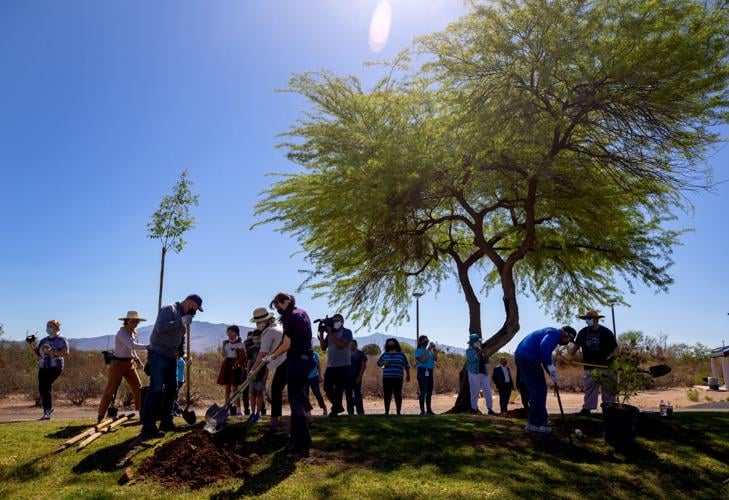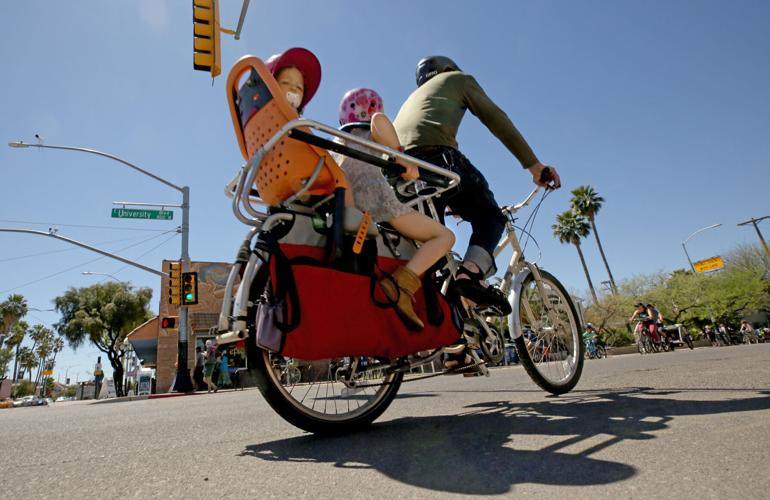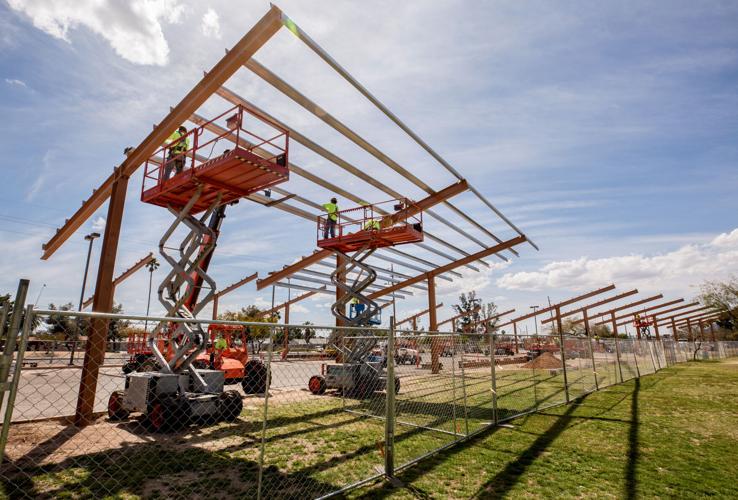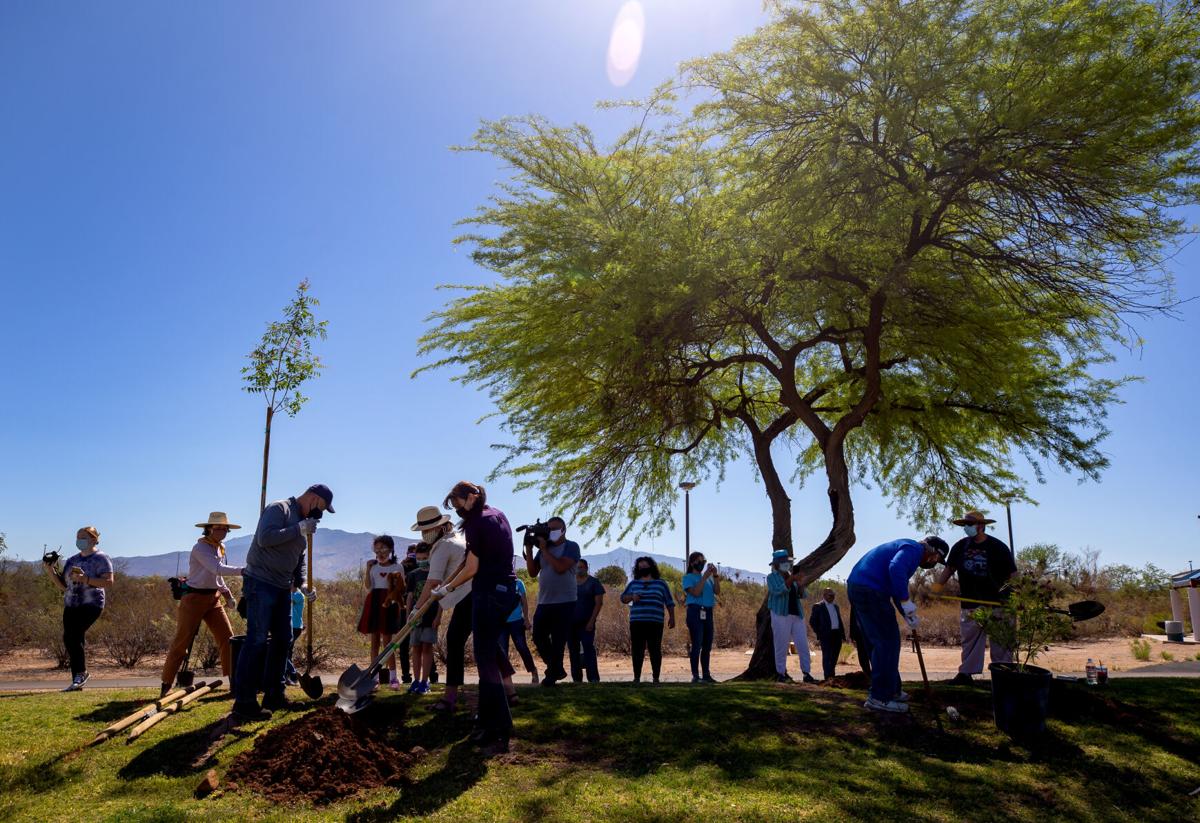A newly adopted climate action plan calls for transforming sprawling Tucson into a “15-minute city,” in which people “can access daily necessities” within a 15-minute walk or bicycle ride from home.
“This means considering clusters of affordable and market-rate housing as well as neighborhood amenities, schools and employment centers located near transit corridors,” the plan says.
It also calls for:
Significant expansion of the city’s transit service and for construction of more pedestrian paths and protected bicycle lanes, in which cyclists are separated from passing cars and trucks.
A dramatic increase in the use of solar power in city buildings and in privately owned buildings, and for the “decarbonization” of city-owned and private buildings by reducing their reliance on coal-fired power plants to supply their electricity.
Significant city support of electric cars and bicycles, including working with the private sector to finance and build electric vehicle charging stations on city-owned land; and creating a subsidized program to share use of electric bikes and cars, especially in neighborhoods with less household access to vehicles.
Creating a “zero waste” Tucson, in which 100% of all garbage and other solid waste is diverted from landfills. One step the plan proposes is to coordinate with trash haulers to establish a citywide curbside collection program for organic waste such as food garbage.
If they’re carried out, these and other proposals in the plan, titled “Tucson Resilient Together,” have the potential to overhaul much of how life is lived in Tucson over the next 25 years. They could potentially transform the city from a conventionally developed, car-dominant Sunbelt metropolis into a more eco-friendly community where people can more easily hop on a bus or streetcar or ride a bike to a solar-powered grocery store or pharmacy.
Can you reach your work, doctor, school and nearest grocery store all within 15 minutes of your home?
If not, would you like to be able to?
The plan’s goal is to have the entire city “carbon neutral” by 2045 and all city facilities achieving the same status by 2030.
Carbon neutrality would mean no more heat-trapping carbon dioxide gases would be released into the air here than are captured by trees and other means within the city.
The City Council voted 5-0 Tuesday to adopt the plan. Although council members’ discussion of the plan was fairly brief before the vote, the plan’s approval followed extensive public input. That included a community survey and nearly 40 public gatherings of various kinds, including workshops, listening sessions, community dialogues and highly informal “pop-up” sessions.
The result was a 156-page plan calling for 24 broad strategies and 122 specific actions to push the city towards its carbon neutrality goal.
Mayor Regina Romero and City Council passed Tucson's Climate Action and Adaptation Plan on Tuesday in a 5-0 vote. Video courtesy of City of Tucson.
“The plan has been in the works for over 14 months and extensive community engagement, (involving) over 5,000 people,” Romero told the council Tuesday. “This is a people-centered climate action plan. It is a framework, a plan to move ahead and forward. I firmly believe that the hard work starts now,” she said.
Costs, money sources unknown
How and when the plan’s principles will be turned into real-world actions on the ground is for now unknown, however..
Of those 24 strategies, the plan predicted that seven would take anywhere from one to 10 years to be implemented. The others’ timetables were described as “ongoing,” meaning they will take a “period of time” to accomplish, said Lane Mandle, chief of staff for the City Manager’s Office.
City Manager Michael Ortega told the council he expects to bring it an implementation timetable by April.
Also unknown is the total cost and sources of the money that will be needed for public improvements and investments to carry out all the plan’s proposals. That includes, for instance, the cost of all the proposed improvements in city infrastructure and increased transit service. The plan’s price tag would also have to cover installation of new “resilience hubs,” where residents could flee the outdoor summertime heat for a cooler atmosphere, water and other resources to help them cope with extreme weather.
Increased funding also likely will be needed for the proposed organic waste collection program; replacing all gasoline-powered city vehicles with electric vehicles; launching the electric car-sharing program; building more sidewalks and bike lanes; and capturing methane gas from the city landfill at the Los Reales Sustainability Campus, among other projects envisioned.
As for the sources of money, “It’s going to be all of the above,” meaning a combination of local, state, federal and private dollars, said Vice Mayor Steve Kozachik. “This is a plan that is going to take years to fully implement, but we don’t want to sit around waiting to get everything laid out before we take the first step.”
“It’s all of the above, but the climate situation is all of ours as well,” he said.
Romero has proven adept at getting federal money for projects, said Councilman Kevin Dahl. The hope for federal help was also brightened by enactment of the federal trillion-dollar infrastructure bill in 2021 and the climate-friendly Inflation Reduction Act in 2022, said Dahl and Kozachik.
“Also, now that we have a governor we can work with, there will be state funds on the table,” said Dahl, referring to new Gov. Katie Hobbs, who like Tucson’s mayor and all its council members is a Democrat.
Romero said in a written statement to the Star: “Working together with people and stakeholders throughout our city, we identified over 100 strategies to help us take action to reduce our own contributions to causing climate change and to be better prepared to deal with the effects of a warming planet. I am committed to funding and implementing as many of these strategies as possible as quickly as possible.”
It’s not uncommon for the city to develop a plan without funding sources in place, said Mandle, of the City Manager’s Office.
“We develop plans all the time, then that helps us get money. Then we are shovel ready for federal funding,” Mandle said. “Having a plan makes us more likely to get those dollars.”

Workers with Park 'N Shade build the steel structure for parking lot solar panels at Reid Park in 2019. Tucson's climate action plan calls for a dramatic increase in the use of solar power in city buildings and in privately owned buildings.
Residents worry about extreme heat
When city officials sought public comments about what residents want from a climate plan, a common theme they heard was concern about increasing extreme heat, the climate report said.
Residents talked of heat “lasting longer” throughout the day, and said Tucson has felt “a lot hotter than it has ever been,” the report said.
People noted that “dealing with extreme heat is tougher for those who are not as financially secure because they either lack the insulation or air conditioning to keep cool, or that it becomes prohibitively expensive to use air conditioning,” the report said. “In addition, extreme heat is particularly dangerous to individuals with chronic health issues and to those who primarily work outdoors.”
Tucsonans put their top priority for climate adaptation solutions around that extreme heat, the report said. Solutions included increased shade through tree cover or shade canopy, especially at transit stops and community centers, along with more and better maintained green space.
“Some suggested shifts in work schedules, both daily and seasonally, to reduce heat exposure for outdoor workers. And others suggested accessible, community spaces where Tucsonans could stay and cool down during high heat days,” the climate report said.
Tree cover and ‘resilience hubs’
Proposals to deal with extreme heat make up one of several key general strategies for attacking the climate issue that top Tucson’s priority list.
Planners determined their “biggest bang for the buck” approach, by running the plan’s many strategies through cost-benefit analyses and other measures to account for their potential for climate mitigation and adaptation. The strategies were also looked at for how they affect equity and environmental justice, financial resources and the feasibility of implementation, “to determine which broader strategies are expected to have the greatest impact in the shortest amount of time,” the plan said.
“All actions listed cannot begin immediately or be implemented concurrently. The city’s existing staff and budgetary resources require us to be strategic with how we proceed with and prioritize these actions,” the plan said.
Specifically, the plan calls for developing and spreading around resources to protect against extreme heat. That will include continued efforts to increase tree cover, particularly in neighborhoods now lacking it. Also important will be splash pads and shade canopies in public spaces.
For Tucson to adapt to extreme heat, the plan said it’s also critical that it swiftly build a network of resilience hubs. They are “safe, comfortable places,” Mandle said.
There, people can get shelter in air-conditioned buildings and other resources they would need during other climate disruptions such as wildfires, floods and power grid outages, the report said.
The climate plan calls for building such hubs in partnership with schools, community-based organizations, neighborhood associations and faith-based institutions. The plan says city officials should work with the Pima County Health Department to develop specifications and best practices for how accessible the hubs should be, what amenities they should contain and how they should be programmed.
The city now offers cooling shelter in six neighborhood centers, but “I don’t think they are adequate,” Dahl said. “I don’t think there is battery backup on any of them” if the power goes out.
“If the grid goes down when it’s hot, there will be lots of places in trouble,” he said. “This is our vision — to think ahead to make sure we’re prepared for something we can see is inevitably going to happen.”

A bicyclist carries a full load along East University Boulevard near North Fourth Avenue during Cyclovia in 2019. Construction of more protected bicycle lanes, in which cyclists are separated from passing cars and trucks, is part of the city's new climate action plan. So is significant city support of electric cars and electric bicycles.
Denser, transit-oriented development
Conversations with community members and urban planners alike also helped lead plan creators to the concept of the “15-minute city,” in which people can access daily necessities by foot or on bicycle.
The goal is to accomplish this through land-use planning and regulation.
The discussions highlighted the need for transit-oriented development, density and affordable housing, the plan said.
“Vehicle-centric urban sprawl has led to a transportation system that is responsible for approximately a third of our community-wide emissions. Electric vehicles and public transit are useful and important tools to reduce emissions from transportation, but the greatest progress will come from shifting our land use and development practices around the principle of a ‘15-minute city’,” the report said.
This will involve creating residential developments near transit, neighborhood amenities, and protected walkways and bike paths.
It will also require moving toward dense and multi-use developments, “and prioritizing affordable and mixed-income housing developments that will give low-income households proximity and access to community resources and mobility services,” the report said.
“These actions will reduce (greenhouse gas) emissions and further climate and environmental justice, by significantly reducing harmful pollution from vehicles and improving access to essential services.”
Solar energy push
Another high priority for the plan is to “decarbonize” the city’s electric grid by reducing its dependence on the fossil fuels coal and natural gas in favor of renewable sources led by solar energy.
An emissions inventory done for the plan revealed that “stationary energy” from purchased gas and electricity represents a substantial majority of greenhouse gas emissions from city operations and the entire community. Decarbonization “is the most substantive and swiftest action we can take to achieve carbon neutrality,” the plan said.
“Renewable energy is becoming increasingly cost-competitive against fossil energy, and there is plenty of precedent across the U.S. supporting the move towards purchasing 100% renewable power,” it added.
Energy is essential for the economic and environmental vitality of Tucson and the world at large, the report said.
“We use various forms of energy to heat and cool our homes and businesses, power lights, cook food, move vehicles, and even pump water from the Colorado River — life as we know it wouldn’t be possible without energy,” the report said. “However, our current energy supply is unsustainable and harmful to people and the planet. That is because we are highly reliant upon fossil fuels such as oil, natural gas, gasoline, and diesel. When these fuels are burned in power plants, furnaces, and engines, they produce harmful air pollutants and greenhouse gas emissions (also known as carbon pollution).”
Twenty-six specific proposals aiming toward an energy future free of fossil fuels are in the plan. One calls for the city to install at least 30 megawatts of solar photovoltaics on city-owned buildings and carports. The plan also calls for the city to engage with Tucson Electric Power and suburban utility Trico to expedite the shift to renewable electricity.
The city should also introduce pilot efforts for new and emerging clean energy technologies, including solar streetlights, the plan said.
For privately owned buildings, the plan recommends the city explore opportunities to streamline permitting for photovoltaic panel installations for homes, commercial and industrial properties. It also urges the city to partner with the private sector to enact a home energy audit and retrofit program for residents, with a priority for low-income families and homeowners.
But decarbonization alone won’t be enough to insure adequate and reliable energy supplies, the plan indicated.
“Decarbonization and electrification must come hand-in-hand with actions that reduce demand and increase the resilience of the grid to assure that Tucsonans have sustainable and reliable energy — when they need it,” the report said.







